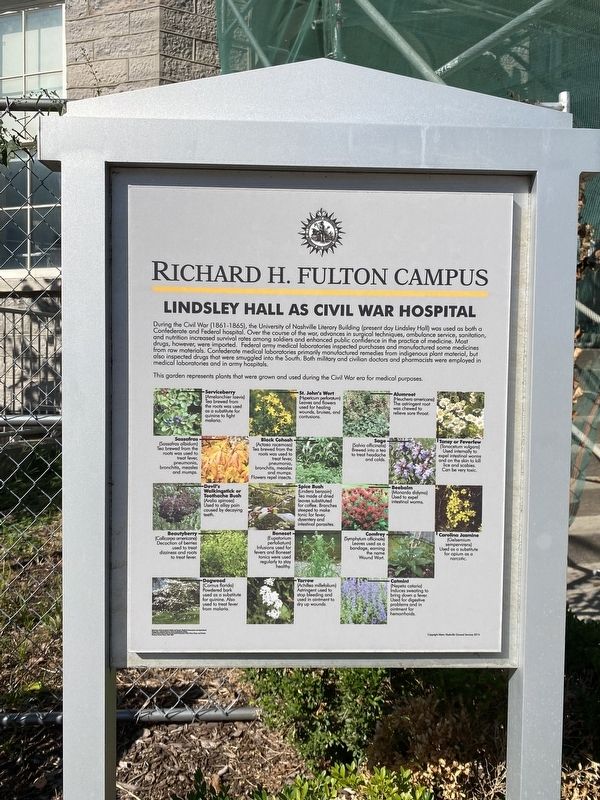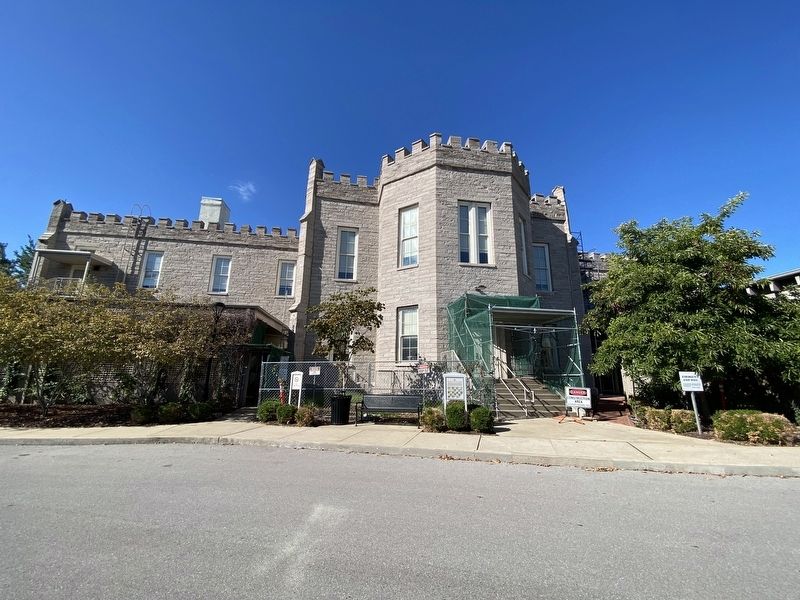Rutledge Hill in Nashville in Davidson County, Tennessee — The American South (East South Central)
Lindsley Hall as Civil War Hospital
— Richard H. Fulton Campus —
Inscription.
During the Civil War (1861-1865), the University of Nashville Literary Building (present day Lindsley Hall) was used as both a Confederate and Federal hospital. Over the course of the war, advances in surgical techniques, ambulance service, sanitation, and nutrition increased survival rates among soldiers and enhanced public confidence in the practice of medicine. Most drugs, however, were imported. Federal army medical laboratories inspected purchases and manufactured some medicines from raw materials. Confederate medical laboratories primarily manufactured remedies from indigenous plant material, but also inspected drugs that were smuggled into the South. Both military and civilian doctors and pharmacists were employed in medical laboratories and in army hospitals.
This garden represents plants that were grown and used during the Civil War era for medical purposes.
Serviceberry (Amelanchier laevis) Tea brewed from the roots was used as a substitute for quinine to fight malaria.
St. John's Wort (Hypericum perforatum) Leaves and flowers used for healing wounds, bruise, and contusions.
Alumroot (Heuchera americana) The astringent root was chewed to relieve sore throat.
Sassafras (Sassafras albidum) Tea brewed from the roots was used to treat fever, pneumonia, bronchitis, measles, and mumps.
Black Cohosh (Actaea racemosa) Tea brewed from the roots was used to treat fever, pneumonia, bronchitis, measles and mumps. Flowers repel insects.
Sage (Salvia afficinalis) Brewed into a tea to treat headache and colds.
Tansy or Feverfew (Tanacetum vulgara) Used internally to expel intestinal worms and on the skin to kill lice and scabies. Can be very toxic.
Devil's Walkingstick or Toothache Bush (Aralia spinosa) Used to allay pain caused by decaying teeth.
Spice Bush (Lindera benzoin) Tea made of dried leaves substituted for coffee. Branches steeped to make tonic for fever, dysentery and intestinal parasites.
Beebalm (Monarda didyma) Used to expel intestinal worms.
Beautyberry (Callicarpa americana) Decoction of berries used to treat dizziness and roots to treat fever.
Boneset (Eupatorium perfoliatum) Infusions used for fevers and Boneset tonics were used regularly to stay healthy.
Comfrey (Symphytum officinale) Leaves used as a bandage, earning the name Wound Wort.
Carolina Jasmine (Gelsemium sempervirens) Used as a substitute for opium as a narcotic.
Dogwood (Cornus florida) Powered bark used as a substitute for quinine. Also used to treat fever
from malaria.
Yarrow (Achillea millefolium) Astringent used to stop bleeding and used in ointment to dry up wounds.
Catmint (Nepeta cataria) Induces sweating to bring down fever. Used for digestive problems and in ointment for hemorrhoids.
Topics. This historical marker is listed in these topic lists: Education • Science & Medicine • War, US Civil.
Location. 36° 9.249′ N, 86° 46.064′ W. Marker is in Nashville, Tennessee, in Davidson County. It is in Rutledge Hill. Marker can be reached from the intersection of 2nd Avenue South and Lindsley Avenue. Touch for map. Marker is at or near this postal address: 730 2nd Ave S, Nashville TN 37210, United States of America. Touch for directions.
Other nearby markers. At least 8 other markers are within walking distance of this marker. Richard H. Fulton Campus (within shouting distance of this marker); Charlie Cardwell Garden (within shouting distance of this marker); a different marker also named Charlie Cardwell Garden (within shouting distance of this marker); Richard H. Fulton (about 300 feet away, measured in a direct line); Nashville Fire Department (about 600 feet away); Site of Waterworks Plant (approx. 0.2 miles away); Captain Ryman's Home (approx. ¼ mile away); Nashville General Hospital (approx. ¼ mile away). Touch for a list and map of all markers in Nashville.
Credits. This page was last revised on October 17, 2023. It was originally submitted on October 14, 2023, by Darren Jefferson Clay of Duluth, Georgia. This page has been viewed 61 times since then and 14 times this year. Photos: 1, 2. submitted on October 15, 2023, by Darren Jefferson Clay of Duluth, Georgia. • James Hulse was the editor who published this page.

